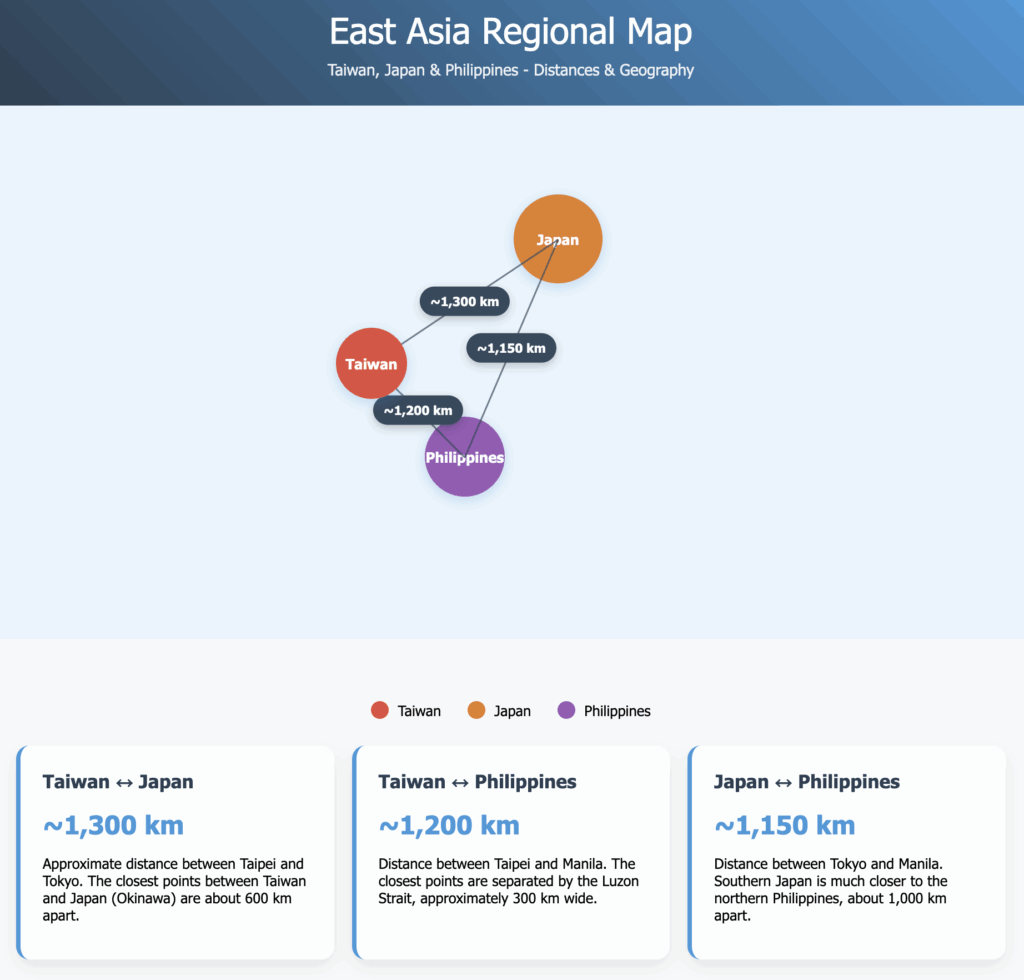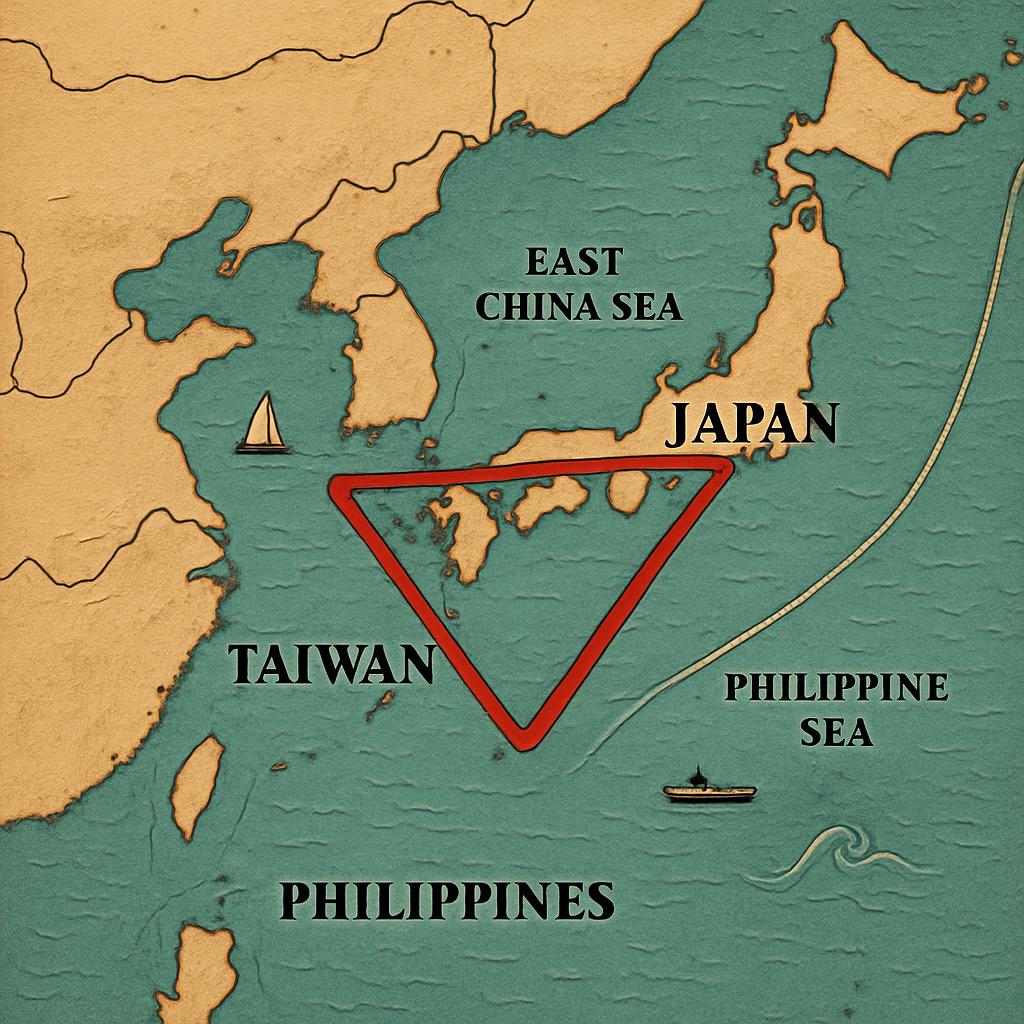While Taiwan tensions are often viewed through a U.S.-China lens, the gravest strategic consequences would fall on Japan and the Philippines. Chinese control of Taiwan would fundamentally alter the regional balance, potentially isolating both nations and forcing them into accommodation with Chinese regional dominance regardless of U.S. positions.
Taiwan’s location at the center of the “First Island Chain” makes it a natural geographic chokepoint. The island sits at the midpoint between Japan’s Southwest Islands to the north and the Philippines’ Luzon archipelago to the south, creating what military strategists call the First Island Chain — a natural barrier that currently contains Chinese naval power within the South and East China Seas. This geographic position gives Taiwan outsized strategic importance far beyond its size.
Located opposite Fujian Province off the Asian continent, Taiwan is nearly the same size as Kyushu, measuring almost 36,000 square kilometers. It sits at the midpoint of the first island chain, the transnational archipelago running south from Japan through Taiwan to the Philippines. The loss of this central link would fundamentally reshape regional security dynamics.

Japan’s Critical Vulnerabilities
Japan’s dependence on Taiwan Strait shipping routes creates an acute vulnerability that Chinese control would immediately exploit. CSIS estimates that 32 percent of Japan’s imports and 25 percent of its exports transit the Taiwan Strait, with over 95% of Japan’s crude oil coming from Middle Eastern countries and much of it transported through this route.
About 6 trillion cubic feet of liquefied natural gas, or more than half of global LNG trade, passed through the South China Sea in 2011. Half of this amount continued on to Japan, with the rest going to South Korea, China, Taiwan, and other regional countries. The geographic reality means that for Japan, roughly $13 billion of its imports also pass through the Luzon Strait, yet this is just a fraction of its imports through the Taiwan Strait.
The PRC views the Senkaku/Diaoyu Islands as part of “Taiwan province” and may seek to take the islands during a conflict. If the PLA Navy were to occupy Taiwan, Japan would struggle to defend its westernmost islands, as well as the Senkaku/Diaoyu Islands, and even Okinawa. This connection transforms Taiwan from a distant concern into an immediate threat to Japanese territory.
The PLA’s shortest passages from China’s mainland to the Pacific Ocean are on the north and south sides of Taiwan. The former is through Japan’s Southwest Islands between Japan’s mainland and Taiwan, and the latter is through the Luzon Strait between Taiwan and the Philippines. Chinese control of Taiwan would breach this natural defensive barrier, fundamentally altering Japan’s strategic environment.
The Philippines’ Dilemma
Any major armed contingency on or around Taiwan would present an economic and humanitarian crisis for the Philippines. As the nearest potential safe harbor, the volume of refugees escaping the conflict would be likely to quickly overwhelm Philippine capacity. The Marcos administration has acknowledged this reality, with the president noting that Taiwan’s proximity to Luzon makes it “hard to imagine” that the country could avoid conflict.
The strategic importance of the Luzon Strait cannot be overstated. Other straits bordering the South China Sea like the Malacca, Sunda and Balabac Straits are too narrow and shallow for submarines to pass through undetected. The Taiwan Strait is adjacent to and heavily monitored by China as well as by Taipei and the US. This makes Luzon Strait critical in all-out war because the nuclear submarines of both China and the US have a better chance of passing through it undetected.
The Luzon Strait is a choke point for access between the South China Sea and the Philippine Sea, and China’s navy uses it to move carrier strike groups and destroyers out to the open Pacific. Access to the strait is necessary for Chinese interests in the event of a Taiwan Strait conflict.
Chinese control of Taiwan would essentially bracket the Philippines between Chinese-dominated waters. The Philippines depends on the strait to transport about one-fifth of its global imports and one-seventh of its exports, but its geography allows it to send much of its trade through the Luzon Strait and Western Pacific Ocean. However, Chinese control of Taiwan would compromise even these alternative routes.
The PRC Perspective
Chinese strategic thinkers explicitly view Taiwan as key to regional domination. Control over Taiwan would transform the Taiwan Strait into China’s “strategic inner lake.” Conversely, so long as the island remained out of China’s hands, it would expose the mainland’s coastal metropolises, seaborne commercial traffic, and the movement of air and naval forces to hostile forces located on Taiwan.
Beijing has long feared that a maritime coalition led by Washington might seek to choke off Chinese access to the seas in a war over Taiwan. Control of the island would thus “shatter the semi-sealed predicament of China’s sea areas” while transforming Taiwan, the central segment of the first island chain, from a barrier into a “portal” to the Pacific.
Chinese forces on the island would be able to radiate power along the first island chain and beyond. From air bases and airports on Taiwan, Chinese aircraft with combat radii of 2,000 kilometers would be able to cover the Yellow and East China Seas, the various straits from Bohai to the north to Bashi to the south, and the Ryukyus, Kyushu, Shikoku, and much of the Philippine archipelago.
Economic and Trade Implications
The Taiwan Strait is the primary route for ships passing from China, Japan, South Korea and Taiwan to points west, carrying goods from Asian factory hubs to markets in Europe, the US and all points in between. Almost half of the global container fleet and 88% of the world’s largest ships by tonnage passed through the waterway.
If cross-strait tensions become especially dire, cautious shipping companies may avoid routes near Taiwan altogether. That same vessel departing from Singapore may choose to sail south of the Philippines before heading north through the Miyako Strait to reach South Korea. This would extend the journey by roughly 1,000 miles, adding significant costs and delays.
Even alternative shipping routes would face Chinese pressure. Many countries would feel the effects of these disruptions, but two key U.S. allies, Japan and South Korea, would be among those most impacted. It would also likely make it infeasible to stop at Chinese ports while en route, which could have significant ripple effects on supply chains given China’s central role in maritime shipping.
Japan’s Evolving Position
Recent remarks from Japanese leaders do not mean Tokyo has pledged to defend Taiwan if China attacks, or that it necessarily commits to supporting the United States militarily if Washington chooses to get involved. Tokyo’s answer would ultimately depend on top-level political judgments about the conflict’s cause, specific nature, and implications for Japan’s peace and security.
However, Current Japanese Prime Minister Kishida Fumio has pledged to double Japan’s defense spending in response to the tense security climate, indicating growing recognition of the stakes involved.
Philippines’ Strategic Balancing
The Philippines has a special economic relationship with Taiwan, but acknowledges the People’s Republic of China (PRC), rather than the Republic of China (Taiwan), as the sole political government of China, and has consistently affirmed the “One China Policy”. However, the Philippine government is now paying more attention to developments in the Taiwan Strait. With the Marcos Jr. Administration, a China policy will likely always be two-pronged: with one prong oriented to Beijing, and another toward Taipei.
Philippine Defense Secretary Gilberto Teodoro said that the region is the “spearhead of the Philippines as far as the northern baseline is concerned,” and that its garrison would be strengthened, reflecting growing awareness of the Luzon Strait’s strategic importance.
Both countries are deepening security ties with the United States. U.S. Marine Corps anti-ship missiles will deploy to the Luzon Strait, a strategic first island chain chokepoint between the Philippines and Taiwan, during Balikatan 2025. The 3rd Marine Littoral Regiment’s Medium-Range Missile Battery will send Naval Strike Missile-equipped systems to the Luzon Strait.
The fourth Taiwan Strait crisis also further motivated Washington to strengthen its alliance with regional powers such as Japan, Australia, and the Philippines.
The Multi-Polar Authoritarian World on the March
Beyond the strategic calculations, the fundamental issue is a question of values. Taiwan is a democratic state and has proven that Chinese culture can embrace democratic values. This is an affront to President Xi and his ideology of authoritarian control and global expansion.
Without any question to assault of Putin and Xi would have a similar motivation, namely, to expand their empires and to recover what is “rightfully theirs.” This is of course true if you are working to create a new global order where middle power democratic states like Australia and Brazil are consider merely commodity providers to the expanding Chinese empire.
In short, while U.S.-China competition dominates headlines about Taiwan, the most profound strategic consequences would fall on Japan and the Philippines. Both nations face the prospect of being isolated from each other and from broader alliance networks, potentially forcing accommodation with Chinese regional dominance regardless of US positions.
China is engaged in a geopolitical competition with the United States and a widening array of allies and partners — Japan and the Philippines most of all — who see their national interests directly threatened by Beijing’s choices. The geographic reality of Taiwan’s central position in the First Island Chain means that its fate will determine whether Japan and the Philippines remain sovereign actors in an open regional order or become subordinated to Chinese regional hegemony.
Understanding Taiwan through this regional lens — rather than purely as a U.S.-China issue —reveals why both Japan and the Philippines are quietly but significantly building defensive capabilities and strengthening security partnerships. For them, Taiwan is not just about U.S-Chinese competition; it is about their fundamental security and sovereignty in the decades ahead.
And for some earlier thoughts during Trump’s first term:
https://breakingdefense.com/2016/12/taiwan-trump-a-pacific-defense-grid-towards-deterrence-in-depth/
And more recently:
Taiwan, U.S. Defense Industry, and the Evolving Strategy for Indo-Pac Defense


